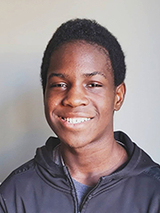Bone Marrow Transplant for Sickle Cell Disease: Asher’s Story
Bone Marrow Transplant for Sickle Cell Disease: Asher’s Story
Asher was adopted from Haiti just before his third birthday. His adoptive parents, Terry and Brad, knew he had serious health issues, and once in the States, he was diagnosed with sickle cell disease. For years, Asher endured pain crises, frequent hospitalizations and blood transfusions. Wanting a different option, he asked for a bone marrow transplant (BMT) that would cause his marrow to correctly produce hemoglobin. Nervously, his parents agreed, and since undergoing the procedure, Asher, now 14, has been doing great.

When Terry and Brad were preparing to adopt Asher, his medical records at the Haitian orphanage were in French, “But I could make out that his hemoglobin was weird,” says Terry. He had already required medical care multiple times in his short life. “We knew we needed to get him home,” says Terry.
During Asher’s trip with Brad from Haiti to the family’s home in New Jersey, he had a pain crisis. “It must have been traumatic, leaving his country, not knowing the language,” says Terry. Upon his arrival, they immediately took him to a nearby hospital, and he was diagnosed with sickle cell disease. In patients with the disease, red blood cells do not correctly produce hemoglobin, the protein that moves oxygen around the body, and the red blood cells become hard and misshapen. Those with the disease can experience episodes of pain, infections, potential organ damage and often early death.
For several years, Asher needed to be hospitalized multiple times a year — one time for acute chest syndrome, a serious condition that causes breathing difficulty and low oxygen levels. When Asher was 8, Terry requested that he get a port placed so he could have regular blood transfusion therapy. “He would just scream and scream every time they had to draw blood,” says Terry. The port and the transfusion therapy every three weeks “alleviated the bulk of the issues,” says Terry. “But it didn’t clear everything.” Asher’s need for hospitalizations dropped to about once a year.
But still, the transfusions every few weeks wore on Asher. “He came to me and said, ‘Mom, I’m done,’” Terry recalls. He wanted the curative therapy of a bone marrow transplant. The family came to the Sickle Cell and Red Cell Disorders Curative Therapy Center (CuRED) at Children's Hospital of Philadelphia (CHOP) to learn their options.

New discoveries, powered by you
Your gift helps fund curative therapies and pain-free lives for children like Asher with sickle cell disease.
Was it difficult to decide to undergo BMT?
“It was for me,” says Terry. “Asher was completely ready. For me, the risks involved made me a wreck for a very long time.” Prior to the BMT, a patient must undergo chemotherapy, which prepares the body to accept the new cells by “making space” in the bone marrow, and also suppresses the patient’s immune system to prevent rejection of the donor cells. “After a point, we just wanted to move forward and have it done,” says Terry.
What advice would you give a family in the same situation?
“First of all, we did a lot of praying,” says Terry. “We asked a lot of questions and did a lot of research online. Connecting with other people who have been through it — that’s been one of my greatest resources. The fact that Asher was absolutely sure he wanted to do it helped a lot. He’s the one who lived through all the pain — sickle cell is a painful disease. I can’t begin to fathom the pain. So listening to him — he was old enough to understand the risks. My advice is to listen to your kids! You can tell if they understand what’s going on.”
How was the BMT process?

“It wasn’t as bad as I thought,” says Terry. “Of course, I wasn’t the one who went through it, but Asher is strong, and he did it with such grace.” Since Asher had no relatives who could be donors, several potential unrelated donors were identified. For a BMT, cells are collected from the donor and administered to the patient like a blood transfusion. After the transplant, the patient stays at CHOP for three to four weeks. The first 100 days after transplant are the most critical. During this time, patients are closely monitored for complications such as graft-versus-host disease and infections.
What stood out to you about CHOP’s care?
“I was impressed,” says Terry. “I felt like they knew what they were talking about — they had the confidence that I needed to see."
“At the CuRED Clinic, they were friendly and personable. Instead of talking at us, they talked to us and with us.”
How was his recovery?
“It’s been good!” says Terry. “He has no complaints.” About eight months after the BMT, Asher’s bloodwork isn’t completely normal, but his hemoglobin has been above 12 — close to the normal range. “That in and of itself is amazing,” says Terry, “because I can’t recall a time it’s ever been like that. And his outlook has changed — he has matured.”